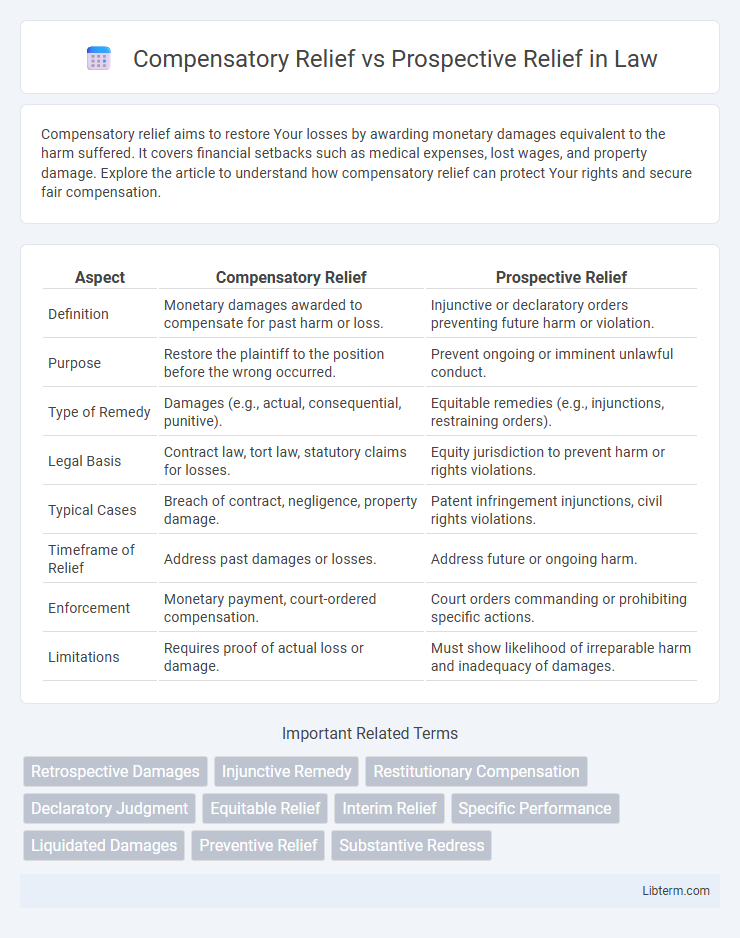Compensatory relief aims to restore Your losses by awarding monetary damages equivalent to the harm suffered. It covers financial setbacks such as medical expenses, lost wages, and property damage. Explore the article to understand how compensatory relief can protect Your rights and secure fair compensation.
Table of Comparison
| Aspect | Compensatory Relief | Prospective Relief |
|---|---|---|
| Definition | Monetary damages awarded to compensate for past harm or loss. | Injunctive or declaratory orders preventing future harm or violation. |
| Purpose | Restore the plaintiff to the position before the wrong occurred. | Prevent ongoing or imminent unlawful conduct. |
| Type of Remedy | Damages (e.g., actual, consequential, punitive). | Equitable remedies (e.g., injunctions, restraining orders). |
| Legal Basis | Contract law, tort law, statutory claims for losses. | Equity jurisdiction to prevent harm or rights violations. |
| Typical Cases | Breach of contract, negligence, property damage. | Patent infringement injunctions, civil rights violations. |
| Timeframe of Relief | Address past damages or losses. | Address future or ongoing harm. |
| Enforcement | Monetary payment, court-ordered compensation. | Court orders commanding or prohibiting specific actions. |
| Limitations | Requires proof of actual loss or damage. | Must show likelihood of irreparable harm and inadequacy of damages. |
Introduction to Legal Relief: Compensatory vs. Prospective
Compensatory relief aims to restore a plaintiff to the position they occupied before the harm occurred by providing monetary damages for losses incurred. Prospective relief, on the other hand, involves court-ordered actions designed to prevent future harm or enforce ongoing obligations, typically through injunctions or specific performance. Understanding the distinction between compensatory and prospective relief is essential in legal strategy, as each serves distinct purposes in addressing past injuries versus preventing future violations.
Defining Compensatory Relief
Compensatory relief is a legal remedy aimed at reimbursing a plaintiff for losses or damages incurred due to another party's wrongful conduct, restoring them to the financial position they occupied before the harm occurred. It involves monetary compensation for actual damages such as lost wages, medical expenses, or property damage. Unlike prospective relief, which seeks to prevent future harm, compensatory relief addresses past injuries and quantifies the plaintiff's economic or non-economic losses.
Understanding Prospective Relief
Prospective relief aims to prevent future harm by ordering actions that ensure compliance with laws or regulations, often seen in injunctions or declaratory judgments. It differs from compensatory relief, which focuses on reimbursing past damages through monetary awards. Understanding prospective relief involves recognizing its role in shaping future conduct to avoid violations rather than addressing previous injuries.
Key Differences Between Compensatory and Prospective Relief
Compensatory relief aims to reimburse the injured party for losses already incurred, often involving monetary damages to restore the plaintiff to their original position. Prospective relief focuses on preventing future harm or enforcing ongoing obligations, typically through injunctions or specific performance. Key differences include the temporal focus, with compensatory relief addressing past damages and prospective relief targeting future compliance or prevention.
Legal Principles Governing Compensatory Relief
Compensatory relief is governed by legal principles that focus on making the injured party whole by awarding damages equivalent to the loss suffered, such as monetary compensation for breach of contract or tortious conduct. Courts assess the actual harm, causation, and foreseeability to determine the appropriate remedial amount, ensuring that the plaintiff is restored to the position they would have occupied absent the wrong. This contrasts with prospective relief, which primarily aims to prevent future harm through injunctions or mandates rather than retrospective monetary recovery.
Legal Standards for Granting Prospective Relief
Legal standards for granting prospective relief require courts to issue injunctions or mandates to prevent future harm when there is a substantial likelihood of ongoing or repeated violations of rights. Courts must evaluate factors such as the likelihood of success on the merits, irreparable harm without relief, balance of equities, and public interest to determine eligibility. Prospective relief emphasizes preventing future legal violations, contrasting with compensatory relief that addresses past harm through monetary damages.
Case Law Illustrations: Compensatory Relief
Compensatory relief aims to restore a plaintiff to the position they were in before the harm occurred by awarding monetary damages, often demonstrated in landmark cases such as *Hadley v. Baxendale* (1854) which set the precedent for foreseeability in damages. In *Hawkins v. McGee* (1929), also known as the "Hairy Hand" case, the court awarded expectation damages reflecting the difference between the value promised and the actual outcome. These cases illustrate compensatory relief's focus on actual loss incurred, emphasizing restitution over punishment or prevention.
Case Law Illustrations: Prospective Relief
Prospective relief, aimed at preventing future harm, is exemplified in landmark cases like *American Power & Light Co. v. SEC*, where courts granted injunctions to stop ongoing violations rather than awarding damages. In *Pennsylvania v. West Virginia*, prospective relief was used to mandate compliance with regulatory standards, emphasizing the prevention of irreparable harm. These cases illustrate the judiciary's focus on forward-looking remedies that enforce obligations and deter future misconduct.
Practical Considerations for Litigants
Compensatory relief aims to reimburse the plaintiff for losses already incurred, requiring detailed evidence of damages and often involving thorough financial documentation. Prospective relief, such as injunctions or declaratory judgments, focuses on preventing future harm, demanding a clear demonstration of ongoing or imminent injury and the inadequacy of monetary damages. Litigants must assess the strength of their evidence for actual damages versus the likelihood of future harm to strategically choose the most effective form of relief.
Conclusion: Choosing the Appropriate Form of Relief
Choosing the appropriate form of relief depends on the specific circumstances of the case and the goals of the plaintiff. Compensatory relief aims to restore the plaintiff to the position they occupied before the harm occurred by providing monetary damages. Prospective relief, such as injunctions or specific performance, focuses on preventing future harm or enforcing ongoing obligations, making it essential when future conduct must be regulated or stopped.
Compensatory Relief Infographic

 libterm.com
libterm.com